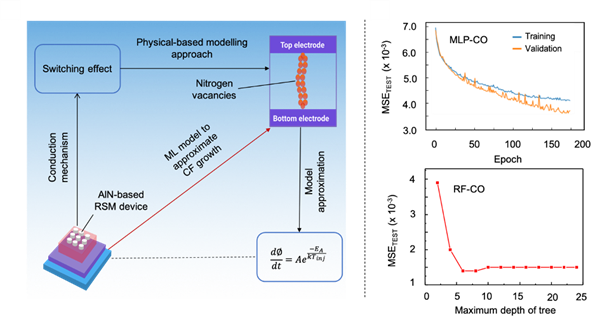SUTD researchers developed new modelling toolkit to predict new-type-of-memory current
SUTD - Karthekeyan Periasamy, Qishen Wang, Shao-Xiang Go, Yu Jiang, Natasa Bajalovic & Desmond. K. Loke
Chang Gung University - Karthekeyan Periasamy, Qishen Wang, Yi Fu and Jer-Chyi Wang
Ming Chi University of Technology - Jer-Chyi Wang
Chang Gung Memorial Hospital - Jer-Chyi Wang
 Overview of the model for predicting the current of the new type of memory.
Overview of the model for predicting the current of the new type of memory.
A significant challenge in the global research efforts towards better energy technologies – efficient and accurate device modelling – may be one step closer to being solved, based on a new technique developed by the Singapore University of Technology and Design (SUTD) researchers.
The SUTD research team, as well as collaborators from Chang Gung University, Taiwan, have created a new modelling toolkit which can predict the current of a new type of memory with excellent accuracy.
Although resistive memory has seen significant improvement in recent years, traditional devices remain limited and prone to permanent device damage due to the incorrect current applied to the device during initial testing, and conventional models need to consider complex behaviors to model the current.
This new peer-reviewed study sets out a novel technique for modelling current, which can significantly reduce risk of permanent device damage. The new modelling technique not only helps to avoid the need to consider complex behaviors, but also has the added benefit of being able to predict the current accurately.
“The most exciting potential applications for resistive memory include edge computing, autonomous driving, visual processing and other applications. Using new tools, like machine learning, to develop a better understanding of how the natural world works can lead to dramatic technological breakthroughs. Our results could allow computer designers to reduce risk of permanent device damage, bringing these applications closer to reality,” noted principal investigator of this study, SUTD’s Assistant Professor Desmond Loke.
Loke added, “We formulated a machine learning model and inferred model parameters by fitting the model to experimental datasets to allow for accurate and reliable predictions and forecasts of the minimum current needed to program a device. Our easy-to-use representation of current can outperform traditional representations improving prediction accuracy by around ten times, a significant step towards practical applications on near-term resistive memory.”
“By developing these new techniques that are tuned to resistive memory limitations, we may enable potential breakthroughs in energy efficiency and storage and beyond.”
The details of this study are published in the journal AIP Advances and are available for other computer designers to use online.
Acknowledgments:
This work was financially supported by the Ministry of Science and Technology, R.O.C. (Contract No. MOST 109-221-E-182-032), Chang Gung Memorial Hospital, Linkou, Taiwan (Contract Nos. CMRPD2H0133, CMRPD2J0052, and BMRPA74), the Ministry of Education (Singapore) (Grant No. MOE2017-T2-2-064), the SUTD-MIT International Design Center (Singapore), the SUTD-ZJU IDEA Grant Program (SUTD-ZJU (VP) 201903), Changi General Hospital (Singapore) (Grant No. CGH-SUTD-HTIF2019-001), Agency of Science Technology and Research (Singapore) (Grant No. A20G9b0135), and the National Supercomputing Centre (Singapore) (Grant No. 15001618). Karthekeyan Periasamy acknowledges the Singapore University of Technology and Design for scholarship support.
Reference:
Modeling electrical conduction in resistive-switching memory through machine learning, AIP Advances. (DOI: 10.1063/5.0052909)